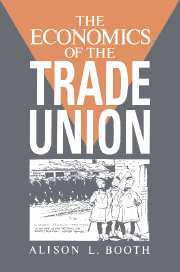Book contents
- Frontmatter
- Contents
- List of figures
- List of tables
- Preface
- 1 Introduction
- 2 The development of the union movements of Britain and the United States
- 3 The orthodox theoretical framework: an overview
- 4 Trade union objectives and the monopoly union model
- 5 Bargaining models of the trade union
- 6 Empirical estimates of the union wage differential
- 7 The impact of trade unions on productivity, investment, profitability, employment and hours
- 8 Unions and the macroeconomy
- 9 Conclusion
- References
- Index
4 - Trade union objectives and the monopoly union model
Published online by Cambridge University Press: 07 October 2009
- Frontmatter
- Contents
- List of figures
- List of tables
- Preface
- 1 Introduction
- 2 The development of the union movements of Britain and the United States
- 3 The orthodox theoretical framework: an overview
- 4 Trade union objectives and the monopoly union model
- 5 Bargaining models of the trade union
- 6 Empirical estimates of the union wage differential
- 7 The impact of trade unions on productivity, investment, profitability, employment and hours
- 8 Unions and the macroeconomy
- 9 Conclusion
- References
- Index
Summary
Introduction
‘What is industrial relations? … The answer … is that it is the study of the rules governing employment, together with the ways in which the rules are made and changed, interpreted and administered … The rules governing employment, and the ways in which they are made and interpreted, cannot be understood apart from the organizations that take part in the process. Industrial relations therefore includes the study of trade unions, management, employers’ associations and the public bodies concerned with the regulation of employment. Each of these organizations has its own sources of authority, and wherever there are separate sources of authority there is the risk of conflict…
The rules themselves are of two main types. There are the rules that settle such issues as pay, the length of the working day, over-time, holidays, and the way in which a job should be done and the time it should take. These are called substantive rules. Then there are the rules that settle the ways in which the substantive rules are made, and the ways in which they can be challenged, changed, interpreted and applied. These are procedural rules.'
(Clegg, 1980: 1–2)This quotation highlights several of the problems facing economists in constructing an analytical model of a unionised labour market, wherein it is necessary to abstract from the diversity of institutions, procedures and outcomes that characterise industrial relations in a unionised economy.
- Type
- Chapter
- Information
- The Economics of the Trade Union , pp. 82 - 119Publisher: Cambridge University PressPrint publication year: 1994



